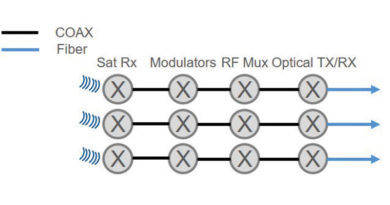Redefining Fiber Optics How Hollow Core Fiber is Pushing the Boundaries
By Steve Harris
Fiber optics play a crucial role in modern telecommunications, enabling faster data transfer, higher bandwidth, longer transmission distances, lower signal loss, energy efficiency, and increased reliability. In our networks, data travels through fibers made of silica (SiO2) by transmitting laser pulses of light. This light is guided through the fiber’s core by a phenomenon known as total internal reflection (TIR).
The fiber consists of a core and a surrounding cladding layer. The cladding has a lower refractive index than the core, causing the light to reflect off the core-cladding boundary, effectively trapping it within the core and allowing it to travel long distances with minimal loss. This waveguide structure ensures that signals remain strong over extended distances, making fiber optics an essential component of high-speed communication networks.
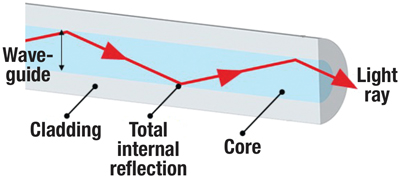
Figure 1. Total internal reflection.
In recent decades, hollow core fiber (HCF) technology has seen remarkable progress. Unlike traditional optical fibers that guide laser light pulses through a solid silica glass core via TIR, HCF features an empty core filled with air or gas, allowing more than 98% of the optical power to travel through the hollow region. This type of fiber employs a hollow central core as a waveguide, surrounded by a specially designed cladding known as photonic bandgap cladding, which is usually made of silica containing a pattern of air holes.
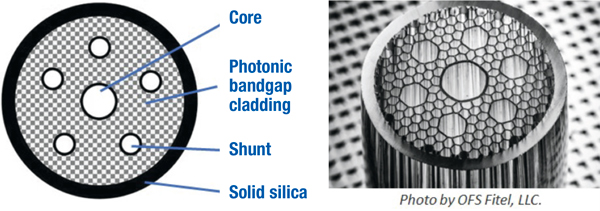
Figure 2. Hollow core fiber2.
The photonic bandgap cladding is engineered to prevent light at specific wavelengths and angles from escaping into the surrounding cladding, effectively confining it within the hollow core. Due to the low index of refraction (IoR) of the air-filled core, laser light pulses travel nearly 32% faster in HCF than in conventional solid glass fibers, shown in Figure 3. This enhanced speed results in light propagation that closely approaches the speed of light in a vacuum, achieving a group index near unity, which enables lower latency and faster data transmission. In air, the speed of light is very close to that of a vacuum, about 299,700,000 meters per second (m/s).
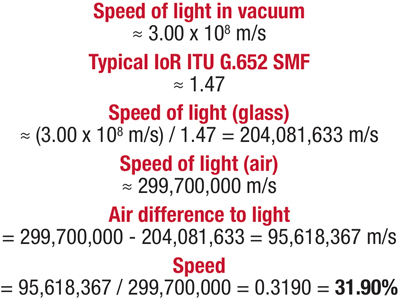
Figure 3. Speed of HCF vs. G.652 fiber.
The use of air and the photonic bandgap effects as a waveguide in HCF significantly reduces latency, with improvements of up to 50%1. This reduction in latency and increase in speed allows for extended reach at the same performance levels for latency-sensitive applications or higher transaction rates. HCF also exhibits lower signal loss, achieving attenuation as low as 0.11 dB/km (according to Optical Fiber Communication Conference 2024 data), compared to conventional ITU G.652 silica fibers, which typically have attenuation between 0.17 dB/km and 0.25 dB/km.
However, HCF faces challenges with bend loss. While standard HCF can tolerate a bend radius of about 70 mm, traditional bend-insensitive fibers, such as ITU G.657.B3, can handle much tighter bends with a radius as small as 5 mm, making them more suitable for compact installations (e.g., MDUs).
Because the HCF core is typically air-filled, its IoR is nearly identical to that of the surrounding air at the fiber’s end face. This similarity in refractive index minimizes Fresnel reflections, eliminating the need for physical contact (PC) connectors. It also significantly reduces back-reflection, which by some figures can lower insertion loss by up to 3.5%.
Moreover, the gas pressure or type within the hollow core can be adjusted to fine-tune the fiber’s properties, helping to mitigate nonlinear effects and optimize performance. HCF’s resistance to radiation further makes it suitable for high-radiation environments. The photonic bandgap guiding mechanism in HCF allows for lower dispersion by providing more precise control over how light travels through the fiber. This design effectively confines light within the hollow core and minimizes the interaction with the cladding, reducing variations in signal speed across different wavelengths and enabling more stable and consistent data transmission.
Although HCF is still in the early stages of its technological development, it represents a breakthrough in optical fiber innovation. The fiber’s advantages in speed, bandwidth, and specialized applications offer significant potential benefits over traditional single-mode fiber (SMF). HCF is well-suited for various applications, including high-speed data (HSD) transmission, ultrashort pulse uses such as quantum technologies, ultra-long-haul communication, data centers, and wavelength-division multiplexing (WDM) systems.
Research is ongoing to further reduce signal loss and improve performance, with companies like Microsoft (through its acquisition of Lumenisity), OFS Fitel, and Sumitomo Electric Lightwave driving advancements in the field. In our industry, Comcast has partnered with Lumenisity to deploy HCF in some of its Philadelphia network infrastructure. Comcast has produced traffic rates ranging from 10 gigabits per second (Gbps) to 400 Gbps all simultaneously on a single strand of HCF fiber3.
As HCF technology matures, it will likely become a pivotal component of our communication infrastructure, shaping the future of HSD transmission and enabling new innovations across various industries.
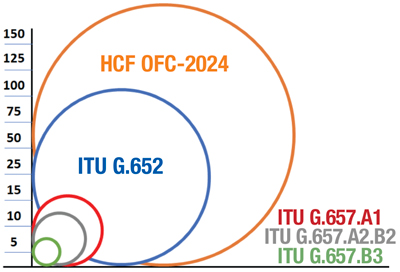
Figure 4. Bending radius HCF vs. ITU G.657.
- A New Generation of Fibre – Beyond Latency, Behind the Headlines
- OFS Optics
- Comcast Deploys Advanced Hollowcore Fiber With Faster Speed, Lower Latency
https://tinyurl.com/3w82pcsh
 Steven Harris
Steven Harris
VP Global Market Development,
SCTE® a subsidiary of CableLabs®
Steve is responsible for overseeing the architecture and evolution of education programs, professional credentialing, and customized career learning journeys, as well as international business development and partnerships for SCTE.
Images provided by author.
Shutterstock



